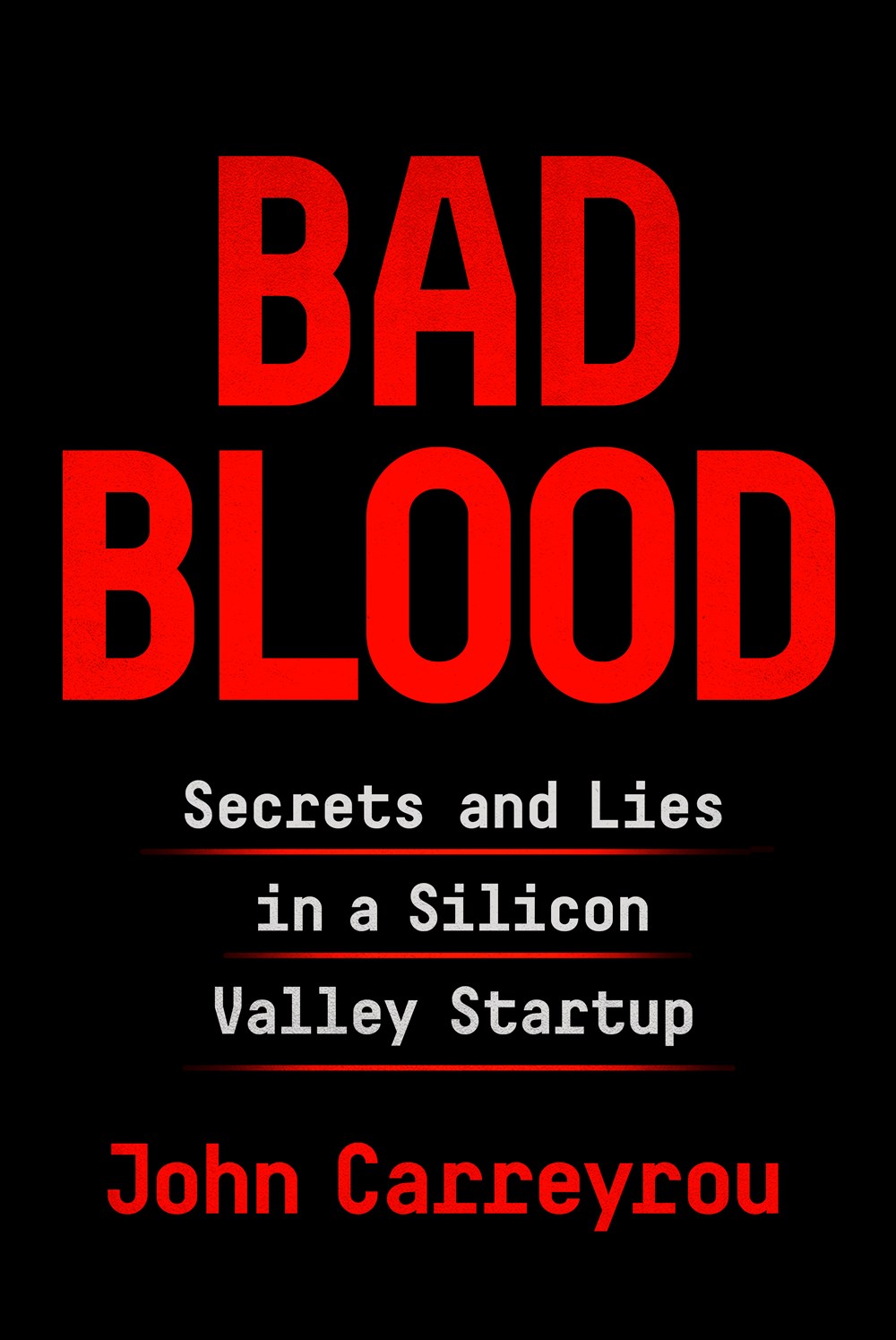Bad Blood: Secrets and Lies in a Silicon Valley Startup
May 25, 2018
John Carreyrou's new book is in part a story about truly atrocious leadership and management, and a powerful reminder of the importance and power of a free press.

Bad Blood: Secrets and Lies in a Silicon Valley Startup by John Carreyrou, Knopf, 352 pages, Hardcover, May 2018, ISBN 9781524731656
If ever there seemed a company destined to succeed, it was Theranos—a Silicon Valley startup with a cutting-edge product, talent and experience in its ranks, a strong management team, and a board that would make a Fortune 100 company jealous. Just three years after its founding, the valuation of the company was one hundred and sixty-five million dollars. It raised $15 million in its first two funding rounds, and added a whopping $32 million in its third. The company’s valuation eventually reached $9 billion, giving its founder Elizabeth Holmes a net worth of $5 billion.
Elizabeth Holmes followed a prototypical path to founding her unicorn company. She dropped out of an elite university, Stanford, after acquiring her first patent for a wearable blood sampling patch. Like many founders, she recruited schoolmates to her new company: Shaunak Roy—a Ph.D. student she had assisted in lab research on enzymes in laundry detergent as a freshman—and the professor who connected the two known as the "face of Stanford’s chemical engineering department” Channing Robertson, who would become a member of Theranos’s board. She also had a great creation story, coming up the the idea for her company after witnessing the slow, low-tech, laborious process of taking blood and testing patients for SARS during a summer internship at the Genome Institute in Singapore. She was charismatic, had an admirable mission to reduce the amount of blood needed to perform tests to that which could be gathered through a finger pinprick, and crafted a perfect pitch about the profound impact such technology would have. Using that pitch, by the time she turned twenty-years-old she had quickly raised nearly $6 million from “a grab bag of investors” to start the company. Unfortunately, her first employee and cofounder, Shaunak Roy, quickly found the engineering challenge of the original idea—for a wearable patch that drew blood, tested it, and wirelessly transmitted the results—would be impossible to crack:
As the money flowed in, it became apparent to Shaunak that a little patch that could do all the things Elizabeth wanted it to do bordered on science fiction. It might be theoretically possible, just like manned flights to Mars are theoretically possible. But the devil was in the details. In an attempt to make the patch concept more feasible, they pared it down to just the diagnostic part, but even that was incredibly challenging.
It would not be the last time Holmes’s vision clashed with the technological realities on the ground. But she had boundless optimism and exuberance—and perhaps most of all, ambition—that seemed destined to make her the wealthy entrepreneurial success, even celebrity, she’s aspired to be since she was young. Unfortunately, her success would be short-lived, and built upon fraud and deception. It is this tale that is brilliantly told by the man who broke the story for the Wall Street Journal in his new book, Bad Blood.
The warning signs were there. The cartridge-and-reader system they eventually settled on required expertise in both microfluidics (to manufacture the small cartridges that held the blood for testing) and biochemistry (to get accurate test results), but collaboration between the two teams was, as the author puts it, “far from optimal.”
Both reported up to Elizabeth but weren’t encouraged to communicate with each other. Elizabeth liked to keep information compartmentalized so that only she has the full picture of the system’s development.
This kind of lack of communication and even secrecy was rampant, and it is clear from the beginning that it was poor leadership and management that undermined Theranos’s laudable mission as much as technological constraints. It gets much, much worse as the book progresses, ending up crossing a line into the truly absurd. But it was the siloing of information and simple lack of communication that caused CFO Henry Mosley—a Silicon Valley veteran who had headed the finance of four other tech companies, two of which he took public—to remain shielded from the fact that the demonstrations of Theranos equipment shown to investors was using recorded results rather than real-time results. It was, simply put, a deception. When he learned of the fakery and suggested they cease such misleading demonstrations until the technology was worked out, Holmes suggested he wasn’t a team player and fired him on the spot. It is the first of countless firings documented in the book, all of which would bleed the best talent and expertise from the company, either in dismissals for questioning the efficacy of the technology, or in resignations over ethical concerns about how the company was proceeding.
For those who remained in the ranks, intimidation seemed to be the preferred management tool. When Ed Ku, who joined the company to oversee its toughest engineering problems, turned down Holmes’s request to run the engineering twenty-four hours a day, he saw that he was suddenly out of favor and cut out of the loop:
Before long, Ed noticed that Elizabeth was making new engineering hires, but wasn’t having them report to him. They formed a separate group. A rival group. It dawned on him that she was pitting his engineering team and the new engineering team against one another in some corporate version of survival of the fittest.
Ed was himself promptly fired, along with twenty other employees, when the rival team's solution was favored over the microfluidic platform of the Theranos 1.0 system.
As more and more people were fired or resigned, nepotism began to take hold. Holmes brought in her boyfriend, Ramesh “Sunny” Balwani, as president of the company. Twenty years her senior, he lacked a basic understanding of the technology, and turned into a tyrant who valued secrecy and loyalty above all else. Her brother Christian joined the company and brought five friends from Duke with him who became known as the Frat Pack. “Their friendship with Elizabeth’s brother,” Carreyrou tells us, “vaulted them above most other employees in the company hierarchy.” Even the friends she hired, however, were increasingly put under constant surveillance. Holmes and Balwani had administrative assistants follow employees on Facebook and report what they were posting there, used security footage to keep track of when everyone arrived and left, and enticed them to work longer hours by having dinner catered at eight or eight-thirty every evening. Balwani berated employees for only working eight hour days. They built dossiers on fired employees to use for leverage. She used one such dossier to deny Henry Mosley, the aforementioned, brief-tenured CFO, his stock options.
Even worse, the technology never actually worked. Ignoring that simple fact, Holmes forged ahead with deploying it in the real world on actual patients. After failing to secure contracts with pharmaceutical companies for use in drug testing, she pitched it to the US military and retailers. All the while, Holmes insisted the technology was good and overinflated the earnings forecasts.
In the wave of attention and investment money Wall Street hedge funds and other traditional companies poured into Silicon Valley looking for greater returns, even as the rest of the country was still recovering from the Great Recession, Theranos drew the attention of Walgreens. Walgreens, a 109-year-old drugstore chain weighed down by bureaucracy, doesn't ordinarily move so fast. But, in this case, under the confluence of easy money in the form of low-interest rates and a downtrodden economy, they quickly set up a pilot project to install Theranos blood readers in thirty to ninety stores. The one serious skeptic of Theranos on the Walgreens' side was eventually forced out of the process by Holmes and Balwani—like so many Theranos employees who asked questions—after continually asking for even the most basic proof that the readers actually worked, including access to the results of the tests they’d done on Walgreens executives, which were never produced. Around 40 Theranos blood gathering sites were eventually opened in Walgreens across Arizona. It would not end well.
Theranos also attempted to “deploy its devices in the Afghan war theater,” an idea sparked in the mind of Holmes after she met James Mattis, the current Secretary of Defense who sat on the corporate board of Theranos at the time it was perpetrating these frauds. That deployment never materialized, but that didn’t stop the company from telling people the devices were being used in the back of humvees in Iraq, in medevac helicopters and operating rooms, a claim that seemed more credible with the presence of Mattis on the board—along with George Schultz, the secretary of state under Reagan often credited with winning the cold war, former secretary of state Henry Kissinger, former secretary of defense William Perry, former Senate Arms Services Committee chairman Sam Nunn, former secretary of defense Bill Perry, former navy admiral Gary Roughead, and former Senate majority leader Bill Frist.
With powerful figures such as these and the deception that weaves throughout the story, Bad Blood often reads like a spy thriller. There is even an old family friend who led a double life as an undercover CIA agent and who attempted to destroy the company over a perceived personal slight. Holmes is the unsuspected villain that built a seemingly miraculous company on a cult of personality, deceptions, and fraud that duped multinational corporations, some of the country’s most successful venture capitalists and senior statesmen, and even members of the press. But it was a member of the press—the author—who exposed it all in the end. The story of how he did so, which makes up approximately the last third of the book, is one of the book's most intrigue-filled and intense sections. I will leave that story for you discover, either in the book or in the Hollywood treatment I think is inevitable—it is just too crazy and compelling a tale not to eventually be made into a film.
Bad Blood tells the story of a noble idea undermined by outsized ambition and ego, and about how one can actively sabotage the potential of a company: bad management and leadership, intimidating employees instead of empowering them to pursue the truth rather than growth, putting loyalty over expertise, profit over purpose, and oneself over the wellbeing of the customers who use the products. It is also a powerful reminder of the importance of a free press, its ability to expose lies and deception, and to hold the powerful accountable to the public they're supposed to serve, written by the man who has done just that.


